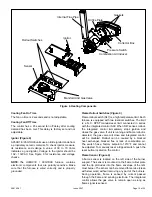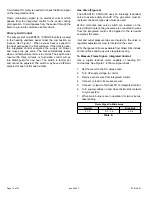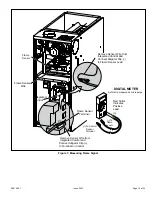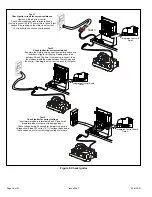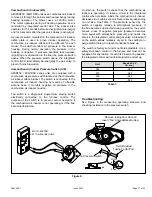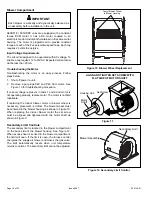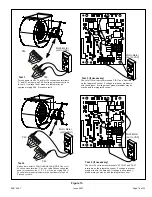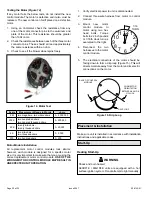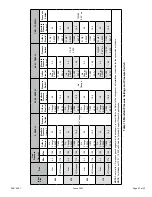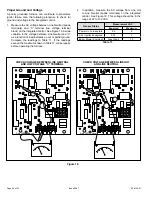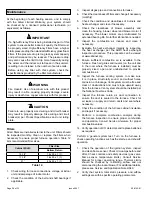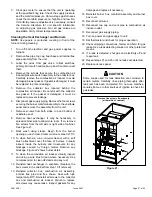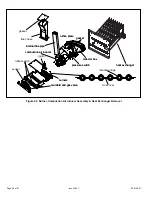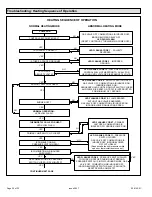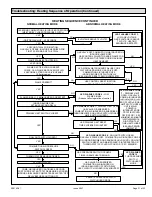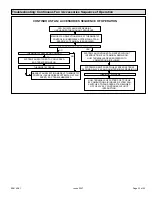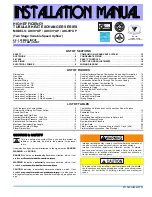
508142-01
Issue 2047
Page 27 of 33
3.
Clock gas meter to ensure that the unit is operating
at the specified firing rate. Check the supply pressure
and the manifold pressure. On two-stage gas furnaces
check the manifold pressure on high fire and low fire.
If manifold pressure adjustment is necessary, consult
the Service Literature for unit specific information
on adjusting gas pressure. Not all gas valves are
adjustable. Verify correct temperature rise.
Cleaning the Heat Exchanger and Burners
NOTE:
Use papers or protective covering in front of the
furnace
during cleaning.
1.
Turn off both electrical and gas power supplies to
furnace.
2.
Remove flue pipe, top cap, flue chase and internal flue
pipe assembly from the unit.
3.
Label the wires from gas valve, rollout switches,
primary limit switch and make-up box then disconnect
them.
4.
Remove the screws that secure the combustion air
inducer/pressure switch assembly to the collector box.
Carefully remove the combustion air inducer to avoid
damaging blower gasket. If gasket is damaged, it must
be replaced to prevent leakage.
5.
Remove the collector box located behind the
combustion air inducer. Be careful with the collector
box gasket. If the gasket is damaged, it must be
replaced to prevent leakage.
6.
Disconnect gas supply piping. Remove the four screws
securing the burner manifold assembly to the vestibule
panel and remove the assembly from the unit.
7. Remove screws from both sides, top and bottom of
vestibule panel.
8.
Remove heat exchanger. It may be necessary to
spread cabinet side to allow more room. If so, remove
five screws from the left side or right side of cabinet.
9.
Back wash using steam. Begin from the burner
opening on each clam. Steam must not exceed 275°F.
10.
To clean burners, run a vacuum cleaner with a soft
brush attachment over the face of burners. Visually
inspect inside the burners and crossovers for any
blockage caused by foreign matter. Remove any
blockage. Figure 22 shows burner detail.
11.
To clean the combustion air inducer visually inspect
and using a wire brush clean where necessary. Use
compressed air to clean off debris and any rust.
12.
Reinstall heat exchanger in vestibule. (Replace the
five screws in the cabinet from step 10 if removed).
13.
Reinstall collector box, combustion air assembly,
internal flue pipe and flue chase. Seal with high
temperature RTV. Reinstall all screws to the collector
box and combustion air inducer. Failure to replace
all screws may cause leaks. Inspect gaskets for any
damage and replace if necessary.
14.
Reinstall burner box, manifold assembly and burner
box cover.
15.
Reconnect all wires.
16.
Reconnect top cap and vent pipe to combustion air
inducer outlet.
17. Reconnect gas supply piping.
18.
Turn on power and gas supply to unit.
19.
Set thermostat and check for proper operation.
20.
Check all piping connections, factory and field, for gas
leaks. Use a leak detecting solution or other preferred
means.
21.
If a leak is detected, shut gas and electricity off and
repair leak.
22.
Repeat steps 21 and 23 until no leaks are detected.
23.
Replace access panel.
Some soaps used for leak detection are corrosive to
certain metals. Carefully rinse piping thoroughly after
leak test has been completed. Do not use matches,
candles, flame or other sources of ignition to check for
gas leaks.
CAUTION
Figure 21.
Remove five screws if necessary
(either side of cabinet)
1
2
3
4
5

